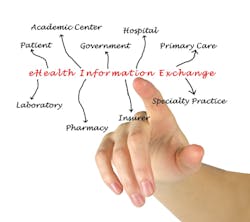The Strategic Health Information Exchange Collaborative (SHIEC), a national collaborative representing health information exchanges (HIEs), has announced the organization’s Patient Centered Data Home (PCDH) initiative is now live and serving tens of millions more patients through the network.
PCDH is a secure health data exchange system that helps patients by proactively alerting their providers when they have a health event away from home, according to SHIEC officials who released the announcement this week.
Specifically, the PCDH network makes this possible by synchronizing patient identity records among the several HIEs whose participants are caring for the patient, as well as providing detail about where the patient record is located for easier, faster query and response. “For patients, this provides reassurance they can receive high-quality, personalized care regardless of where they are in the country,” officials note.
This national launch unifies three smaller regional implementations in which 17 HIEs worked together to prove the concept of inter-HIE information sharing and notification. These regional implementations (the western implementation, the heartland implementation and the central implementation, each which involved coordination among multiple HIEs spanning geographic areas and states) had been set up for months, and now the regions have all been connected to each other. Based on the success of the implementations, the participating HIEs have each agreed to a common, national agreement for participation, which set the stage for connecting the regional implementations together and rolling out the full-scale, national implementation, according to officials.
As SHIEC executives explained, at its core, PCDH is an inter-HIE notification and data sharing system that allows a patient’s records to follow them wherever they seek care. When a patient presents at a medical facility away from home, that facility will generate an admission, discharge, transfer (ADT) message. This message includes demographics about the patient; information such as the patient’s name, the patient’s location in the hospital, his or her address, phone number, gender, etc. By including ZIP code information in the ADT, PCDH can automatically detect when a patient is being treated within a ZIP code outside of their normal home area.
When these events occur, the “away” HIE alerts the HIE in the patient’s “home” area, and that home HIE, known as the patient’s “data home,” automatically lets the treating HIE know they have records for the patient so the treating HIE can generate a query to access those records. Once the treatment encounter concludes, PCDH also makes it possible for the “away” HIE to alert the patient’s home HIE that there are new records for their patient that the home HIE providers can access in order to better care for the patient on an ongoing basis. This new capability makes it possible for a patient’s comprehensive medical history to follow them wherever they seek treatment.
According to Dan Porreca, executive director for New York State-based HEALTHeLINK and chair of the SHIEC board of directors, “The HIEs working together to create PCDH built a powerful foundation for interoperability between HIEs—and we managed to do it using our current technologies. We’re very proud of this accomplishment and the milestone we’ve achieved. We also created and agreed to a national, legally-binding agreement, which laid the foundation for HIEs sharing data with each other across state lines and throughout communities.”
Other HIE leaders around the U.S. have reacted with great optimism regarding PCDH being rolled out on a national level. John Kansky, president and CEO of the Indiana HIE said in a statement, “This is a significant step toward national interoperability. Almost every single state has several healthcare markets that cross inter-state, inter-HIE lines; for example, northwest Indiana is suburban Chicago. PCDH now allows us to exchange data between HIEs for those markets, providing a huge benefit to our patients.”
Added Leigh Sterling, executive director, East Tennessee Health Information Network (eTHIN), “etHIN realized the benefits of PCDH from the outset. Through PCDH, not only do we receive data for patients living in this area who are treated elsewhere while traveling, we are now able to notify other HIEs when their patients are treated here. etHIN’s region contains the most visited national park in the country. Because visitors to our area often seek medical attention while they are here, we have medical data on patients living in all 50 states. PCDH is the best way to provide needed information to our local treating providers and to keep the patient’s hometown physicians informed of out-of-town treatment events.”


